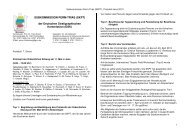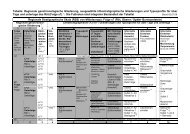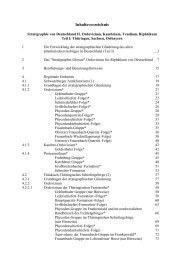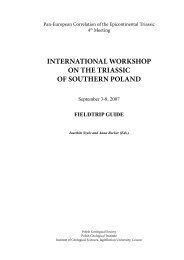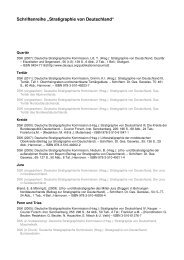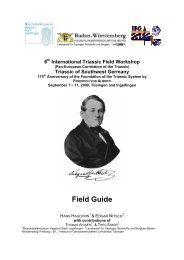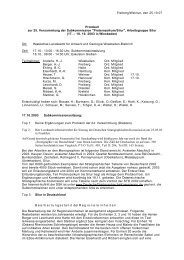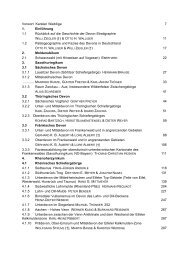International Field Workshop on 'The Triassic of eastern France'
International Field Workshop on 'The Triassic of eastern France'
International Field Workshop on 'The Triassic of eastern France'
You also want an ePaper? Increase the reach of your titles
YUMPU automatically turns print PDFs into web optimized ePapers that Google loves.
sedimentary break period <strong>of</strong> by-pass with first development <strong>of</strong> paleosols (i.e. ‘Z<strong>on</strong>e limite violette’, Müller,<br />
1954; Ortlam, 1967; Gall et al., 1977). This episode could be equivalent <strong>of</strong> Hardegsen Formati<strong>on</strong>, where the<br />
evidence <strong>of</strong> biological activity (ichnites, rhizolites, palynomorphs) not allows a correlati<strong>on</strong> with the arid<br />
c<strong>on</strong>diti<strong>on</strong> <strong>of</strong> the ‘C<strong>on</strong>glomérat principal’ Formati<strong>on</strong>. Similary, the disc<strong>on</strong>tinuity observed in the Paris Basin<br />
corresp<strong>on</strong>ds to the Hardegsen unc<strong>on</strong>formity, representing <strong>on</strong>e <strong>of</strong> the most pr<strong>on</strong>ounced extensi<strong>on</strong>al tect<strong>on</strong>ic<br />
event observed in the German <strong>Triassic</strong> (Trusheim, 1961, 1963; Wolburg, 1968; Röhling, 1991).<br />
In the German Basin, the base <strong>of</strong> the Solling Formati<strong>on</strong> corresp<strong>on</strong>ds to the erosi<strong>on</strong>al episode <strong>of</strong> the<br />
Hardegsen unc<strong>on</strong>formity, during which 100 m <strong>of</strong> Middle Buntsandstein deposits could be locally eroded<br />
(Aigner and Bachmann, 1992). Moreover Geluk (1998) shows that the base <strong>of</strong> the Solling Formati<strong>on</strong><br />
becomes progressively younger to the west, accompanied by a decrease in thickness. In this study, this<br />
formati<strong>on</strong> appears to be missing due to n<strong>on</strong>-depositi<strong>on</strong> or erosi<strong>on</strong>. The Solling sandst<strong>on</strong>es preserved in the<br />
basin could be equivalent to an episode <strong>of</strong> sediment by-pass at the basin margin.<br />
The Röt Formati<strong>on</strong>, corresp<strong>on</strong>ding to evaporitic marine and sabkha deposits, represents the first<br />
occurrence <strong>of</strong> halite depositi<strong>on</strong> in the Germanic Basin. It could be equivalent to the B5 cycle. The cycles B6<br />
and B7 could be equivalent to the first cycle <strong>of</strong> the Muschelkalk in the central Germanic Basin.<br />
II.4. – C<strong>on</strong>clusi<strong>on</strong> and perspectives<br />
The early <strong>Triassic</strong> can be separated into two phases. The first phase, during the Scythian, is<br />
characterized by braided fluvial systems evolving laterally into lake deposits toward the central part <strong>of</strong> the<br />
Germanic Basin. At this time, the basin is a huge basin depressi<strong>on</strong> with <strong>on</strong>ly few marine c<strong>on</strong>necti<strong>on</strong>s in the<br />
<strong>eastern</strong> part. The stratigraphic cycles reflect relative lake-level fluctuati<strong>on</strong> that could be attributed to<br />
sediment supply and/or lake level variati<strong>on</strong> in an arid c<strong>on</strong>text. The sec<strong>on</strong>d phase occurs after a major<br />
sedimentary break (planati<strong>on</strong> surface and pedogenesis) followed by the formati<strong>on</strong> <strong>of</strong> the Hardegsen<br />
unc<strong>on</strong>formity. This surface is tect<strong>on</strong>ically deformed, leading to the creati<strong>on</strong> <strong>of</strong> a new sedimentati<strong>on</strong> area to<br />
the west <strong>of</strong> the basin. Above this unc<strong>on</strong>formity, the fluvial sedimentati<strong>on</strong>, attributed to the Anisian, shows an<br />
enhanced development <strong>of</strong> floodplains (with preservati<strong>on</strong> <strong>of</strong> paleosol) associated with lacustrine envir<strong>on</strong>ment.<br />
The fluvial systems are c<strong>on</strong>nected with a shallow sea in communicati<strong>on</strong> with the Tethys Ocean. In this<br />
c<strong>on</strong>text, the stratigraphic cycles are induced by variati<strong>on</strong>s in relative sea level and/or sediment supply. The<br />
fluvial deposits are preserved in an exoreic basin.<br />
In the dry climatic regime <strong>of</strong> the Lower <strong>Triassic</strong> (van der Zwan and Spaak, 1992), the first cycles<br />
could be attributed to lake and sediment supply variati<strong>on</strong>s in an arid envir<strong>on</strong>ment. During the Olenekian, the<br />
river catchment areas are mainly located in the present-day Armorican Massif, and the paleocurrents are<br />
generally oriented towards the NNE (Fig. II.10). The facies associati<strong>on</strong> are essentially composed <strong>of</strong> stacked<br />
channel-fill facies with very few flood plain deposits (< 3%) and without paleosols. Channels fills are<br />
sometimes associated with aeolian deposits. In more distal areas <strong>of</strong> the Germanic Basin, the sedimentati<strong>on</strong><br />
corresp<strong>on</strong>ds to ephemeral playa lakes or aeolian deposits (Clemmensen, 1979, Clemmensen and Tirsgaard<br />
1990; Aigner and Bachman, 1992; Ulicny, 2004). In this c<strong>on</strong>text, two hypotheses could explain the<br />
preservati<strong>on</strong> <strong>of</strong> fluvial systems. According to <strong>on</strong>e hypothesis, the siliciclastic sediment supply from the<br />
Hercynian- (Variscan) mountain was c<strong>on</strong>stant, and thus the cycles result solely from lake level fluctuati<strong>on</strong>s.<br />
21



